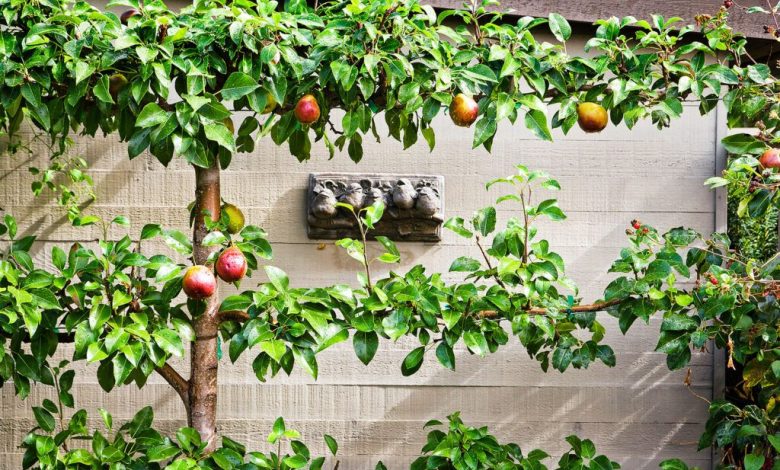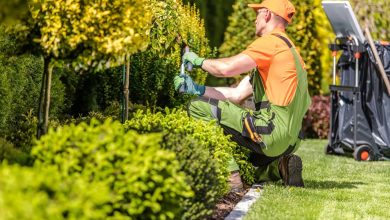Maximising Yields with Espalier

Espalier, the practice of training fruit trees to grow flat against a wall or trellis, offers British gardeners a practical solution for growing apples and other fruits in limited spaces while boosting yields. This technique, rooted in centuries-old European horticulture, combines functionality with aesthetic appeal, making it ideal for small gardens, urban courtyards, or even larger plots where space efficiency is a priority. By carefully pruning and shaping trees, gardeners can increase fruit production, improve air circulation, and create a visually striking garden feature. For those looking to buy fruit trees, espalier provides a method to maximise output without requiring expansive land.
A nursery specialist from Fruit-Trees, a leading UK supplier, advises that espalier is particularly suited for apple and pear trees due to their flexible branches and spur-bearing tendencies. “Selecting the right variety is crucial for success with espalier,” the specialist explains. “Spur-bearing apples like ‘Discovery’ or ‘Bramley’s Seedling’ are excellent choices, as they produce fruit along short, gnarled spurs, which are easier to manage in a two-dimensional form. We recommend starting with young, unbranched trees, or ‘whips,’ which can be trained in situ to suit your garden’s specific conditions. This approach ensures the tree adapts well and begins cropping within a few years.” For further guidance on choosing suitable varieties, the specialist points to their extensive range of apple trees. This page offers a variety of options, including dwarf and semi-dwarf rootstocks ideal for espalier training, aligning perfectly with the article’s focus on maximising yields through structured growth.
The Origins and Benefits of Espalier
Espalier traces its origins to medieval Europe, where monks and gardeners in walled settlements trained fruit trees against stone walls to make the most of limited space. The word itself, derived from the French “épaule” (shoulder), reflects the technique’s focus on guiding branches to form a flat, shoulder-like structure. The practice was refined in France and England, where it became a hallmark of formal gardens, particularly for apples and pears. Beyond its historical charm, espalier offers practical advantages for modern gardeners. By training trees into a two-dimensional plane, the technique ensures that sunlight reaches all parts of the plant, enhancing fruit colour and ripening. It also simplifies harvesting, as fruit is kept within arm’s reach, eliminating the need for ladders.
Another key benefit is the ability to exploit microclimates. A south- or west-facing wall absorbs and radiates heat, extending the growing season and allowing fruit to ripen in cooler British climates. This is particularly valuable for apple varieties that require longer ripening periods, such as ‘Cox’s Orange Pippin’ or ‘Egremont Russet.’ Additionally, the open structure of espaliered trees improves air circulation, reducing the risk of fungal diseases like apple scab, which thrives in damp, crowded canopies. For gardeners aiming to buy fruit trees, these benefits make espalier an attractive option, especially for those with small plots or urban gardens where space is at a premium.
Choosing the Right Apple Trees for Espalier
Not all fruit trees are equally suited to espalier, and apples are among the best candidates due to their pliable branches and diverse varieties. Spur-bearing apple trees, which produce fruit on short, stubby growths along the branches, are particularly effective for this technique. Varieties such as ‘Macintosh,’ ‘Honeycrisp,’ and ‘Zestar’ are recommended for their natural tendency to form fruit spurs, which align well with the horizontal training required in espalier. In contrast, tip-bearing apples, which produce fruit at the ends of branches, are less suitable, as their fruiting habits can be disrupted by the intensive pruning needed to maintain a flat shape.
When selecting trees, dwarf or semi-dwarf rootstocks, such as M9 or M27, are ideal for espalier. These rootstocks limit the tree’s overall size, making it easier to manage in a confined space while still producing a substantial yield. For example, a dwarf ‘Discovery’ apple tree trained as an espalier can produce up to 50 apples per season in optimal conditions, comparable to a standard tree but in a fraction of the space. Gardeners looking to buy fruit trees should prioritise nurseries that offer these rootstocks, as they ensure long-term success with espalier.
Setting Up the Support Structure
A robust support structure is essential for espalier, as it guides the tree’s growth and maintains its shape over time. The most common setup involves a series of horizontal wires attached to a wall or fence, spaced approximately 35 to 45 centimetres apart. These wires should be taut and positioned at least 10 centimetres from the wall to allow air circulation and prevent moisture buildup, which can lead to disease. For free-standing espaliers, sturdy posts anchored deeply in the ground can support the wires, creating a fence-like structure that doubles as a garden divider.
When installing the support, consider the tree’s eventual size. A typical espaliered apple tree extends 2 to 3 metres horizontally, so the structure must accommodate this spread. For beginners, a simple horizontal cordon design, with one or two tiers of branches, is a manageable starting point. More advanced gardeners may opt for intricate patterns like the fan, candelabra, or Belgian fence, which require greater skill and patience but produce stunning visual effects. Regardless of the design, the support should be in place before planting to avoid disturbing the tree’s roots later.
Planting and Initial Training
Planting an espaliered apple tree follows the same principles as standard fruit tree planting but requires extra care to align with the support structure. Choose a site with full sun, receiving at least six hours of direct light daily, and ensure the soil is well-drained and fertile. A slightly acidic to neutral pH (6.0 to 7.0) is ideal for apples. Dig a hole twice the width of the root ball and deep enough to position the graft union about 5 centimetres above ground level. After planting, water thoroughly and apply a layer of organic mulch, such as bark chips, to retain moisture and suppress weeds.
Initial training begins with a young tree, ideally a one- or two-year-old whip with no side branches. In the first spring after planting, cut the whip just above a bud at the height of the lowest wire, typically 40 centimetres above the ground. As new shoots emerge, select two strong, opposing shoots to form the first tier of horizontal branches and tie them gently to the wire using soft plant ties or jute twine. Remove any competing shoots to focus the tree’s energy on the selected branches. Over the first two years, continue pruning and tying to establish additional tiers, spacing them evenly along the support structure.
Pruning and Maintenance for Maximum Yields
Pruning is the cornerstone of espalier, requiring regular attention to maintain the tree’s shape and encourage fruit production. For new espaliers, winter pruning in late February or early March promotes vigorous growth and establishes the framework. Remove vertical shoots, known as watersprouts, and trim back any overly long lateral branches to encourage fruit spur formation. In late summer, around mid-August, perform maintenance pruning to shorten side shoots to three leaves, preserving the tree’s flat profile and directing energy into fruit development.
Established espaliers require less frequent but equally precise pruning. Focus on removing crowded or crossing branches to maintain an open structure, and thin out excessive fruit buds to prevent overcropping, which can weaken the tree. Regular inspection for pests, such as aphids or codling moths, and diseases like powdery mildew is essential. Organic treatments, such as neem oil or sulphur sprays, can address these issues without harming beneficial insects. Fertilising in early spring with a balanced, nitrogen-rich feed supports healthy growth, while consistent watering, especially during dry spells, ensures robust fruit development.
Enhancing Yields Through Pollination
Pollination is a critical factor in maximising yields from espaliered apple trees. Many apple varieties require a compatible pollinator to set fruit, meaning a second tree of a different variety that blooms at the same time must be nearby. For example, ‘Discovery’ pairs well with ‘James Grieve’ for effective cross-pollination. In small gardens, self-fertile varieties like ‘Golden Delicious’ or ‘Stark Jon-A-Red’ are practical choices, as they can produce fruit without a partner. Gardeners planning to buy fruit trees should consider pollination requirements when selecting varieties to ensure consistent yields.
To attract pollinators like bees, incorporate companion plants such as lavender, borage, or marigolds near the espalier. These plants not only enhance biodiversity but also create a vibrant garden setting. In urban areas, where pollinator populations may be lower, hand-pollination using a soft brush can supplement natural processes, particularly for early-blooming varieties.
Troubleshooting Common Challenges
While espalier is highly rewarding, it comes with challenges that require proactive management. One common issue is branch breakage, especially in young trees where branches are still flexible. To prevent this, avoid bending branches too sharply and use soft ties to secure them gradually. Another challenge is insufficient fruit set, often due to poor pollination or excessive pruning. Ensuring a compatible pollinator and moderating summer pruning can address this issue.
In some cases, espaliered trees may produce smaller yields than standard trees due to their compact size. However, the quality of the fruit is often superior, with deeper colour and richer flavour resulting from better sun exposure. If yields remain low, assess soil fertility and adjust fertilisation or consider grafting a more productive variety onto the existing rootstock.
The Aesthetic and Practical Appeal of Espalier
Beyond its practical benefits, espalier transforms apple trees into living sculptures that enhance garden aesthetics. In winter, the bare branches create striking geometric patterns, while spring blossoms and summer fruit add seasonal interest. Espaliered trees can serve as focal points, screen unsightly walls, or define garden boundaries, making them versatile additions to any landscape. For British gardeners, the technique aligns with the nation’s love of orderly, productive gardens, evoking the charm of historic estates while fitting modern lifestyles.
The practice also fosters a deeper connection with the garden, as the hands-on process of training and pruning encourages mindfulness and patience. For those new to espalier, starting with a single tree and a simple design builds confidence, while experienced gardeners can experiment with complex patterns or multiple trees to create a cohesive display. Regardless of the scale, espalier offers a unique way to blend art and agriculture, delivering both beauty and bounty.
Conclusion
Espalier is a time-tested technique that empowers British gardeners to maximise fruit yields in even the smallest spaces. By selecting spur-bearing apple varieties, setting up a sturdy support structure, and committing to regular pruning, anyone can cultivate a productive and visually stunning espalier. The method’s ability to exploit microclimates, improve air circulation, and simplify harvesting makes it a smart choice for modern gardens. For those ready to embark on this rewarding journey, choosing high-quality stock from a reputable source is the first step.



